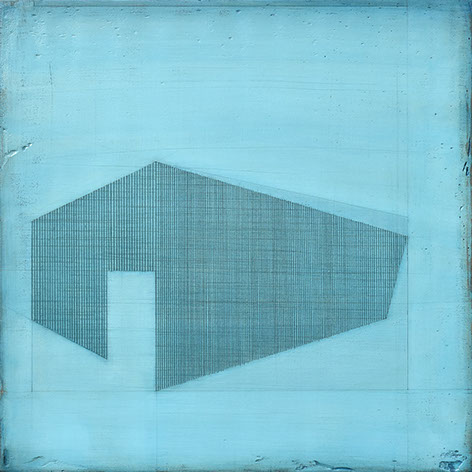
Essay by Rebecca Sitar from the catalogue for Fully Awake 5:6 a cycle of exhibitions embracing an inter-generational approach to celebrating the practice and teaching of painting.
Curated by Sean Kaye and Ian Hartshorne at The Freelands Foundation, London, 2019.
I seem to remember first seeing a painting by Mali Morris in a group show at Francis Graham Dixon Gallery on a day study visit to London, it was probably during my first year on BA(Hon) Fine Art Painting at Winchester School of Art. What struck me at the time was the exuberant and playful use of colour; its luminosity partly registered through a lightness of touch and its joyful animated presence, embodied through its trace movement in the paintings inherent stillness.
In thinking back to what pleasure it brought me, the experience brings to mind something I read recently in an essay by Siri Hustvedt titled Drama of Perception: looking at Morandi. Hustvedt reflects on a particular visual engagement that may more readily arise when viewing a Morandi painting. In part that a colour is seen and felt in the body first before it is named. This proprioceptive register is something very much akin to that which I experienced on my first viewing a painting by Mali. Subsequently I met Mali whilst she was a visiting tutor at Winchester and I was a student. That generosity and openness of spirit so apparent in her paintings, was very much there in her teaching too, she was receptive and encouraging and instilled in me the importance of play within the creative process; of learning to let go, something I still hold dear today.
I first met Susan during my first year teaching at The University of Bolton in 2000. A mature student with a background working in architecture, Susan already had a developed aesthetic sensibility. As personal supervisor to Susan in her final year I was able to oversee her develop a series of paintings as part of an expanded practice. Her final show comprised of three-dimensional painted assemblages, created through a minimalist approach to form and colour, whilst still allowing for an emotional register. Though well informed of the languages she was working with, her approach was more intuitively led, rather than following any predetermined conceptualisation or doctrine.
Teaching can be a collaborative working alliance between tutor and student, a meeting of minds; there to facilitate dialogues to enable developments and insights to be made, primarily by the student. At its best, there are times when ideas unfold; new ways of thinking, seeing and making are exchanged and as such both parties make discoveries and learn in sync. This I certainly encountered with Susan whilst teaching her. Amongst so many rewards in teaching I am grateful for those moments when it is not only I who is doing the 'showing' but the student reveals to me that which was otherwise yet to be said or seen anew.
We are constantly blasted with visual information, to the extent we may no longer look and see. Susan’s pared down landscapes bring order, balance and control to an often chaotic visual world as she observes the distant and mundane and brings to the viewer a new ordered sense of beauty.
Susan’s paintings, like the landscape she is inspired by, reach their outcome after a slow, long process of give and take, adding to and taking away.
Stef Mitchell
Artist and Curator
On looking at photographic images of Drifting I, a work that appears sparse, yet up close is richly and imperfectly textured, I am reminded of a similar experience of getting caught up in the physical details an inch or so away from Agnes Martin's large format abstract works. However, unlike that subjectless painter's work, Drifting I holds open a space between the primacy of material, the quavering, scratched visual field and a barely-there narrative snapshot of what might be snowfields at dusk. Taking seriously that painterly dialectic between its function as emotive, symbolistic window-to-the-soul and as opaque, modernist object, this work's shadowed, white borders also lend it a 'polaroid' quality, hinting at an as-yet undeveloped, or perhaps lost, momentary vision.
Significantly, Laughton's titles ostensibly refer to events and objects figured in a bleak Northern landscape: drifting snow, getting lost and finding one's way, clouds, traces of journeys and storms. Yet, as attention to the physical working and reworking of her paintings reveals, these words and phrases refer as much to the process of raw materials - acrylic, gouache and plaster - dragging and 'drifting', tracing and layering right there on the canvas, as they do to any inner or outer world.
Becky Hunter
Writer and UK Editor of Whitehot magazine.
The work by Susan Laughton shimmers with subdued colour, elegant and restrained but captured fleeting glimpses of landscape and structure you sometimes don’t remember seeing. The combination of craftsmanship and intelligence leaves a lasting impression.
Hilary Angle
Artist
It’s not often that I insist people see something up close to appreciate its beauty, but in the case of Susan Laughton’s work, I do. The iridescence of each piece, and the sense of stillness they exude, requires more than just a jpeg. Each trace line has meaning, each tiny mark a message like some kind of artist hieroglyphics. The overall effect is incredibly calm & beautiful.
Fiona Bailey
The White Gallery
Photographer